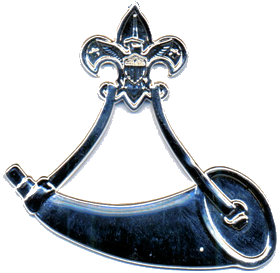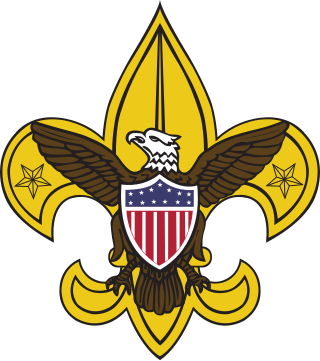
The Boy Scouts of America is one of the largest scouting organizations and one of the largest youth organizations in the United States, with over 1 million youth, including 176,000 female participants. The BSA was founded in 1910; about 130 million Americans have participated in its programs, which are served by 477,000 adult volunteers. BSA became a founding member organization of the World Organization of the Scout Movement in 1922.

Eagle Scout is the highest rank attainable in the Scouts BSA program by the Boy Scouts of America (BSA). Since its inception in 1911, only four percent of Scouts have earned this rank after a lengthy review process. The Eagle Scout rank has been earned by over 2.5 million youth.

Advancement and recognition in the Boy Scouts of America is a tradition dating from the inception of the Scouting movement. A fundamental purpose of advancement is the self-confidence a young man or woman acquires from his participation in Scouting. Advancement is one of the methods used in the "Aims and Methods of Scouting"– character development, citizenship training and personal fitness.

Cub Scouting is part of the Scouting program of Scouting America, formerly known as Boy Scouts of America (BSA), available to boys and girls from kindergarten through fifth grade, or 5 to 10 years of age and their families. Its membership is the largest of the five main BSA divisions. Cub Scouting is part of the worldwide Scouting movement and aims to promote character development, citizenship training, personal fitness, and leadership.

A variety of religious emblems programs are used by the Boy Scouts of America (BSA) to encourage youth to learn about their faith and to recognize adults who provide significant service to youth in a religious environment. These religious programs are created, administered and awarded by the various religious groups, not the BSA, but each program must be recognized by the BSA.

Venturing is a core program of the Boy Scouts of America for young men and women ages 14 through 20. It is one of the Boy Scouts' three programs for older youth, which also include Sea Scouts and Exploring. The purpose of Venturing is to provide a positive environment where youth members, called Venturers, can lead the adventure, take on new leadership roles, and mature into responsible adults.

A King's Scout is a Scout who has attained the King's Scout Award. The King's Scout Award is the highest youth award achievable in the Scouting movement in the Commonwealth realms, including the United Kingdom, Canada, Australia, and New Zealand, where Scouts operate under the patronage of King Charles III. Whether the award recipient is a Queen's or King's Scout depends on who is the current monarch of the Commonwealth realms.

Sea Scouts is a program of the Boy Scouts of America for young men and women ages 14 through 20.

The Boy Scouts of America (BSA) use uniforms and insignia to give a Scout visibility and create a level of identity within both the unit and the community. The uniform is used to promote equality while showing individual achievement. While all uniforms are similar in basic design, they do vary in color and detail to identify the different membership divisions of Cub Scouting, Scouts BSA and Venturing. Many people collect BSA insignia such as camporee and jamboree emblems, council shoulder strips and historical badges.

Powder Horn was a skills resource course for Venturing and Scouts BSA leaders and youth of the Boy Scouts of America (BSA). Powder Horn is also described as a "hands-on resource management course" designed to give Scouting leaders "the contacts and tools necessary to conduct an awesome high-adventure program" in their Scouting unit. The goals of Powder Horn were to help Scout leaders safely conduct outdoor activities of a fun and challenging nature, provide an introduction to the resources necessary to successfully lead youth through a program of high adventure, and familiarize participants with the skills involved in different high adventure disciplines. The Powder Horn course would also introduce Venturing leaders to the Ranger youth award program, so adults may better help Venturers in meeting the Ranger award requirements. Powder Horn presented a wide variety of hands-on high adventure skills experiences, and thus was not designed to provide specific skills certifications. The course is meant to be held over a one-week period or two three-day weekends. Youth attendees would get first-hand experience and information as well as resources so they could better act as Event Chairs for their units.

Scouts BSA is the flagship program and membership level of the Boy Scouts of America (BSA) for coeducational young people between the ages of typically 11 and 17. It provides youth training in character, citizenship, personal fitness, and leadership, and aims to develop the skills necessary to become successful adults.

The Distinguished Eagle Scout Award (DESA) is a distinguished service award of the Boy Scouts of America (BSA). It is awarded to an Eagle Scout who has achieved extraordinary national-level recognition, fame, or eminence within their profession and/or service to the nation and has a strong record of voluntary service to their community. Stringent criteria begins with a minimum of 25 years from the official record date the Eagle Scout rank was earned, a nomination process, selection committee review, and approval by the National Eagle Scout Association. It is one of only two BSA awards presented to adults dependent upon the recipient's having been awarded Eagle Scout as a youth; the other is the NESA Outstanding Eagle Scout Award (NOESA). Recipients of the DESA are known as Distinguished Eagle Scouts.
The Ranger Award is an award available to youth in the Venturing program of the Boy Scouts of America, to encourage and recognize proficiency in skills.

The advancement program for Scouts participating in the Scouts BSA program of the Boy Scouts of America is symbolized by the earning of seven ranks. The advancement program is often considered to be divided into two phases. The first phase from joining to First Class is designed to teach the scout Scoutcraft skills, how to participate in a group and to learn self-reliance. The Scout badge is awarded when the Scout demonstrates a rudimentary knowledge of the Scouting ideals and program. Tenderfoot, Second Class, and First Class have progressively harder requirements in the areas of Scoutcraft, physical fitness, citizenship, personal growth and Scout Spirit.

Square knot insignia are embroidered cloth patches that represent awards of the Scout associations throughout the world.
The rank insignia system of the Indonesian Scouting movement Gerakan Pramuka Indonesia is by and large militarized in traditions and outfit.

The Venturing Summit is the highest rank for youth in the Venturing program of the Boy Scouts of America. It requires Venturers to earn the Pathfinder Rank, participate in adventures, and demonstrate leadership, service and personal growth.
The emblem of the International Spirit Award is worn as a temporary patch by both youth and adult leaders in the Boy Scouts of America. The award recognizes those who have broadened their knowledge of international Scouting and increased their appreciation and awareness of different cultures and countries. This award replaces the International Activity Patch (1991-2012).

In the Boy Scouts of America, a Scout leader refers to the trained leaders of a Scout unit. Adult leaders are generally referred to as "Scouters," and the youth leaders are referred to by their position within a unit. In all Scouting units above the Cub Scout pack and units serving adolescent Scouts, leadership of the unit comprises both adult leaders (Scouters) and youth leaders (Scouts). This is a key part of the Aims and Methods of Scouting. In order to learn leadership, the youth must actually serve in leadership roles.


















